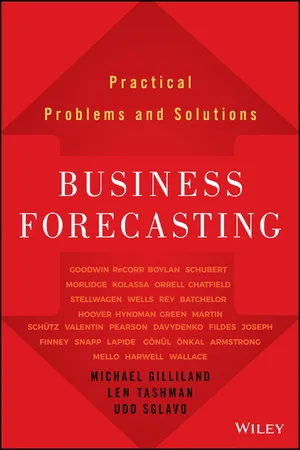
Business Forecasting
Practical Problems and Solutions
Michael Gilliland, Len Tashman, Udo Sglavo
- English
- ePUB (handyfreundlich)
- Über iOS und Android verfügbar
Business Forecasting
Practical Problems and Solutions
Michael Gilliland, Len Tashman, Udo Sglavo
Über dieses Buch
A comprehensive collection of the field's most provocative, influential new work
Business Forecasting compiles some of the field's important and influential literature into a single, comprehensive reference for forecast modeling and process improvement. It is packed with provocative ideas from forecasting researchers and practitioners, on topics including accuracy metrics, benchmarking, modeling of problem data, and overcoming dysfunctional behaviors. Its coverage includes often-overlooked issues at the forefront of research, such as uncertainty, randomness, and forecastability, as well as emerging areas like data mining for forecasting.
The articles present critical analysis of current practices and consideration of new ideas. With a mix of formal, rigorous pieces and brief introductory chapters, the book provides practitioners with a comprehensive examination of the current state of the business forecasting field.
Forecasting performance is ultimately limited by the 'forecastability' of the data. Yet failing to recognize this, many organizations continue to squander resources pursuing unachievable levels of accuracy. This book provides a wealth of ideas for improving all aspects of the process, including the avoidance of wasted efforts that fail to improve (or even harm) forecast accuracy.
- Analyzes the most prominent issues in business forecasting
- Investigates emerging approaches and new methods of analysis
- Combines forecasts to improve accuracy
- Utilizes Forecast Value Added to identify process inefficiency
The business environment is evolving, and forecasting methods must evolve alongside it. This compilation delivers an array of new tools and research that can enable more efficient processes and more accurate results. Business Forecasting provides an expert's-eye view of the field's latest developments to help you achieve your desired business outcomes.
Häufig gestellte Fragen
Information
CHAPTER 1
Fundamental Considerations in Business Forecasting
- Recognition of uncertainty and the need for probabilistic forecasts
- The essential elements of a useful forecast
- Measurement of forecastability and bounds of forecast accuracy
- Establishing appropriate benchmarks of forecast accuracy
- The importance of precisely defining demand when making demand forecasts
- Guidelines for improving forecast accuracy and managing the forecasting function
To generate forecasts as accurate and unbiased as can reasonably be expected—and to do this as efficiently as possible.